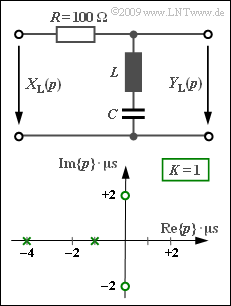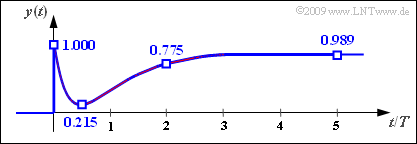Difference between revisions of "Aufgaben:Exercise 3.5: Circuit with R, L and C"
| Line 3: | Line 3: | ||
}} | }} | ||
| − | [[File:P_ID1776__LZI_A_3_5.png|right|frame| | + | [[File:P_ID1776__LZI_A_3_5.png|right|frame|Two-port network with $R$, $L$ and $C$]] |
| − | + | We consider a two-port network with the resistance $R = 100 \ \rm \Omega$ in the longitudinal branch, while in the transverse branch an inductance $L$ and a capacitance $C$ are connected in series. The pole–zero diagram is drawn below. | |
| − | + | Note the normalization of the complex frequency $p = {\rm j} \cdot 2 \pi f$ to the value $1/T$ with $T = 1 \ \rm µ s$. As a consequence, for example the pole at $-1$ in reality is at $-10^6 \cdot \ \rm 1/s$ . | |
| − | + | To compute time functions, the residue theorem can be applied: | |
| − | * | + | *For $N$ simple poles, the output $y(t)$ is composed of $N$ natural oscillations (''residuals'') . |
| − | * | + | *For a simple pole at $p_{{\rm x}i}$, the following holds for the residual: |
:$${\rm Res} \bigg |_{p \hspace{0.05cm}= \hspace{0.05cm}p_{{\rm x}i}} | :$${\rm Res} \bigg |_{p \hspace{0.05cm}= \hspace{0.05cm}p_{{\rm x}i}} | ||
\hspace{-0.7cm}\{Y_{\rm L}(p)\cdot {\rm e}^{p t}\}= | \hspace{-0.7cm}\{Y_{\rm L}(p)\cdot {\rm e}^{p t}\}= | ||
| Line 18: | Line 18: | ||
\hspace{0.05cm} .$$ | \hspace{0.05cm} .$$ | ||
| − | : | + | :However, this approach only works if the number $Z$ of zeros is less than $N$. In this exercise, for example if the step response $\sigma(t)$ is computed. In this case, $Z = 2$ and $N = 3$ apply since the step function at the input must additionally be taken into account by $X_{\rm L}(p) = 1/p$ . |
| − | * | + | *This approach does not work for the computation of the impulse response $h(t)$ due to $Z = N =2$ . |
| − | * | + | *Here, the fact that the integral over the impulse response $h(t)$ results in the step response $\sigma(t)$ can be considered. |
| Line 41: | Line 41: | ||
<quiz display=simple> | <quiz display=simple> | ||
| − | { | + | {What is the function of the two-port network considered here? Is it |
|type="()"} | |type="()"} | ||
| − | - | + | - a low-pass filter, |
| − | - | + | - a high-pass filter, |
| − | - | + | - a band-pass filter, |
| − | + | + | + a band-stop filter? |
| − | { | + | {Compute $L$ and $C$ for the given pole–zero configuration. Consider the normalization value $1/T$ and the resistance $R = 100 \ \rm \Omega$. |
|type="{}"} | |type="{}"} | ||
$L \hspace{0.24cm} = \ $ { 20 3% } $\ \rm µ H$ | $L \hspace{0.24cm} = \ $ { 20 3% } $\ \rm µ H$ | ||
| Line 55: | Line 55: | ||
| − | { | + | {Compute the output signal $y(t) = \sigma(t)$ wenn am Eingang eine Sprungfunktion $x(t) = \gamma(t)$ anliegt. Geben Sie die folgenden Signalwerte ein: |
|type="{}"} | |type="{}"} | ||
$y(t = 0) \ = \ $ { 1 3% } | $y(t = 0) \ = \ $ { 1 3% } | ||
Revision as of 17:15, 18 October 2021
We consider a two-port network with the resistance $R = 100 \ \rm \Omega$ in the longitudinal branch, while in the transverse branch an inductance $L$ and a capacitance $C$ are connected in series. The pole–zero diagram is drawn below.
Note the normalization of the complex frequency $p = {\rm j} \cdot 2 \pi f$ to the value $1/T$ with $T = 1 \ \rm µ s$. As a consequence, for example the pole at $-1$ in reality is at $-10^6 \cdot \ \rm 1/s$ .
To compute time functions, the residue theorem can be applied:
- For $N$ simple poles, the output $y(t)$ is composed of $N$ natural oscillations (residuals) .
- For a simple pole at $p_{{\rm x}i}$, the following holds for the residual:
- $${\rm Res} \bigg |_{p \hspace{0.05cm}= \hspace{0.05cm}p_{{\rm x}i}} \hspace{-0.7cm}\{Y_{\rm L}(p)\cdot {\rm e}^{p t}\}= Y_{\rm L}(p)\cdot (p - p_{{\rm x}i})\cdot {\rm e}^{\hspace{0.05cm}p \hspace{0.05cm}t} \bigg |_{p \hspace{0.05cm}= \hspace{0.05cm}p_{{\rm x}i}} \hspace{0.05cm} .$$
- However, this approach only works if the number $Z$ of zeros is less than $N$. In this exercise, for example if the step response $\sigma(t)$ is computed. In this case, $Z = 2$ and $N = 3$ apply since the step function at the input must additionally be taken into account by $X_{\rm L}(p) = 1/p$ .
- This approach does not work for the computation of the impulse response $h(t)$ due to $Z = N =2$ .
- Here, the fact that the integral over the impulse response $h(t)$ results in the step response $\sigma(t)$ can be considered.
Please note:
- The exercise belongs to the chapter Inverse Laplace Transform.
Questions
Solution
- Bei extrem tiefen Frequenzen $(f \rightarrow 0)$ hat die Kapazität $C$ einen unendlich großen Widerstand und bei sehr hohen Frequenzen $(f \rightarrow \infty)$ die Induktivität $L$.
- In beiden Fällen gilt $Y(f) = X(f)$ ⇒ $H(f) = 1$.
- Bei der Resonanzfrequenz $f_0$ wirkt dagegen die LC–Serienschaltung als Kurzschluss und es gilt $H(f = f_0) = 0$.
- Daraus folgt allein aus dem Blockschaltbild: Es handelt sich um eine Bandsperre.
(2) Aus dem Pol–Nullstellen–Diagramm ergibt sich die folgende $p$–Übertragungsfunktion $($ohne den Normierungsfaktor $1/T)$:
- $$H_{\rm L}(p)= \frac {(p - {\rm j} \cdot 2)(p + {\rm j} \cdot 2)} {(p +1)(p +4 )}= \frac {p^2 +4} {p^2 + 5 \cdot p +4} \hspace{0.05cm} .$$
- Unter Berücksichtigung der Spannungsteilereigenschaften erhält man mit dem Blindwiderstand $p \cdot L$ der Induktivität und dem Blindwiderstand $1/(p \cdot C)$ der Kapazität für die Schaltung:
- $$H_{\rm L}(p)= \frac { p\cdot L +1/(pC) } {R + p \cdot L +1/(pC) }= \frac { p^2 +1/(pC) } {p^2 + p \cdot {R}/{L} +1/(pC) }\hspace{0.05cm} .$$
- Durch Vergleich erkennt man unter Berücksichtigung des Normierungsfaktors $1/T= 10^6 \cdot \rm 1/s$:
- $${R}/{L} \hspace{0.25cm} = \hspace{0.2cm} 5 \cdot 10^{6 }\, {\rm 1/s} \hspace{0.3cm}\Rightarrow \hspace{0.3cm}L= \frac{100\, {\rm \Omega}}{5 \cdot 10^6 \, {\rm 1/s}}\hspace{0.15cm}\underline{= 20\,{\rm µ H} \hspace{0.05cm}} ,$$
- $${1}/({LC}) \hspace{0.25cm} = \hspace{0.2cm}4 \cdot 10^{12 }\, {\rm 1/s^2} \hspace{0.3cm}\Rightarrow \hspace{0.3cm}C= \frac{1}{4 \cdot 10^{12 }\, {\rm 1/s^2}\cdot 2 \cdot 10^{-5 }\, {\rm \Omega \cdot s} } \hspace{0.15cm}\underline{= 12.5\,{\rm nF}} \hspace{0.05cm} .$$
(3) Die Sprungfunktion am Eingang wird durch $X_{\rm L}(p) = 1/p$ berücksichtigt. Damit ergibt sich
- $$Y_{\rm L}(p)= \frac {p^2 +4} {p \cdot (p +1)\cdot(p +4 )} \hspace{0.05cm} ,$$
woraus man durch Anwendung des Residuensatzes die Zeitfunktion $y(t)$ ermitteln kann:
- $$y_1(t) \hspace{0.25cm} = \hspace{0.2cm} \frac {p^2 +4} { (p +1)\cdot(p +4 )} \cdot {\rm e}^{\hspace{0.05cm}p \hspace{0.05cm}t} \bigg |_{p \hspace{0.05cm}= \hspace{0.05cm}0}= 1 \hspace{0.05cm} ,$$
- $$ y_2(t) \hspace{0.25cm} = \hspace{0.2cm} \frac {p^2 +4} { p\cdot(p +4 )} \cdot {\rm e}^{\hspace{0.05cm}p \hspace{0.05cm}t} \bigg |_{p \hspace{0.05cm}= \hspace{0.05cm}-1}= - {5}/{3}\cdot {\rm e}^{ \hspace{0.05cm}-t} \hspace{0.05cm} ,$$
- $$ y_3(t) \hspace{0.25cm} = \hspace{0.2cm} \frac {p^2 +4} { p\cdot(p +1 )} \cdot {\rm e}^{\hspace{0.05cm}p \hspace{0.05cm}t} \bigg |_{p \hspace{0.05cm}= \hspace{0.05cm}-4}= {5}/{3}\cdot {\rm e}^{ \hspace{0.05cm}-4t}$$
- $$\Rightarrow \hspace{0.3cm}y(t)= y_1(t)+y_2(t)+y_3(t)= 1- {5}/{3}\cdot {\rm e}^{ \hspace{0.05cm}-t/T}+\ {5}/{3}\cdot {\rm e}^{ \hspace{0.05cm}-4t/T} \hspace{0.05cm} .$$
Hierbei ist berücksichtigt, dass die bei dieser Rechnung nicht berücksichtigte Konstante $10^6 \cdot \rm 1/s$ durch die Zeitnormierung auf $T = 1 \ \rm µ s$ ausgeglichen wird.
Die gesuchten Signalwerte lauten:
- $$y(t = 0) \hspace{0.05cm}\underline{= 1.000}\hspace{0.05cm}, \hspace{0.15cm}y(t = 0.5\,{\rm µ s}) \hspace{0.05cm}\underline{= 0.215}\hspace{0.05cm}, $$
- $$y(t = 2\,{\rm µ s}) \hspace{0.05cm}\underline{= 0.775}\hspace{0.05cm}, \hspace{0.15cm}y(t = 5\,{\rm µ s}) \hspace{0.05cm}\underline{= 0.989}\hspace{0.05cm}. $$
Die Grafik zeigt den Signalverlauf. Die gesuchten Zahlenwerte sind nochmals eingetragen.
Man erkennt aus dieser Darstellung:
- Da extrem hohe Frequenzen durch das System (Bandsperre) nicht beeinflusst werden, ist auch im Ausgangssignal $y(t)$ der Sprung von $0$ auf $1$ mit unendlich großer Flankensteilheit zu erkennen.
- Wegen $H(f = 0) = 1$ ergibt der Grenzwert von $y(t)$ für $t → \infty$ folgerichtig ebenfalls den Wert $1$.
- Aufgrund der LC–Resonanzfrequenz bei $f_0 = 1/\pi$ (in $\rm MHz)$ kommt es zu einem Einbruch im Signalverlauf.
- Das Signalminimum von $\approx 0.215$ liegt bei etwa $t = 0.5 \ \rm µ s$.
(4) Richtig sind die Lösungsvorschläge 1 und 3:
- Die Impulsantwort $h(t)$ ergibt sich aus der Sprungantwort $\sigma(t)=y(t)$ durch Differentiation:
- $$h(t)= \frac{{\rm d}\hspace{0.1cm}y(t)}{{\rm d}t}= \delta (t) + \frac {5}{3T}\cdot {\rm e}^{ \hspace{0.05cm}-t/T}- \frac {20}{3T}\cdot {\rm e}^{ \hspace{0.05cm}-4t/T} \hspace{0.05cm} .$$
- Der erste Lösungsvorschlag ist somit richtig, da die Differentiation einer Sprungfunktion die Diracfunktion liefert.
- Für den kontinuierlichen Anteil von $h(t)$ erhält man folgende Zahlenwerte:
- $$T \cdot h(t = 0 )\hspace{0.25cm} = \hspace{0.2cm} {5}/{3}- {20}/{3}= -5 \hspace{0.05cm} ,$$
- $$ T \cdot h(t = T )\hspace{0.25cm} = \hspace{0.2cm} {5}/{3}\cdot {\rm e}^{ \hspace{0.05cm}-1}- {20}/{3}\cdot {\rm e}^{ \hspace{0.05cm}-4}= {5}/{3}\cdot 0.368- {20}/{3}\cdot 0.018\approx 0.491 \hspace{0.05cm} .$$
- Da $h(t)$ im Grenzfall für $t → \infty$ gegen Null strebt, ist der dritte Lösungsvorschlag ebenfalls richtig im Gegensatz zum zweiten.
- Der Verlauf von $h(t)$ ist in der nebenstehenden Grafik dargestellt.


